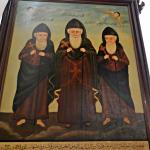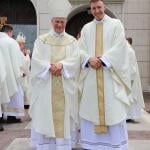 At the end of the 4th century, a theological battle was being waged over what status Origen and his disciples should be given by the Church. As an elderly bishop, St Epiphanius of Salamis had been working for over a decade to have a universal condemnation placed upon Origen. Following in the footsteps of St Methodius, he thought Origen was a dangerous enemy of orthodoxy.[i] As soon as Epiphanius recruited St Jerome to his side, we can the two different sides of the war emerging, with several important ecclesiastical figures on each side. We find St Epiphanius and St Jerome, with all the associates and friends they could muster taking on the opposition to Origen, while we find John (the bishop of Jerusalem), Rufinus (an old friend of St Jerome who was about to feel the wrath of his former comrade), and all the friends and associates they could bring together to defend Origen. Although there were previous skirmishes between the two sides, a major battle happened when Epiphanius ordained St Jerome’s brother (Paulinian) to the priesthood while in Palestine, and therefore, outside of his jurisdictional authority.[ii] In a letter defending his actions, Epiphanius stated that John was an Origenist. Since a good offence is often the best defense, Epiphanius wrote at length on what he believed were Origen’s major heresies.[iii] At this point, since he was being charged with heresy, John enlisted the aid of Theophilus as an outsider to mediate the dispute. Seeing the situation for what it was, Theophilus wanted to help heal the rupture that had occurred between Epiphanius and John of Jerusalem. Indeed, he was able to help calm down the situation, making him somewhat successful in his mission.[iv] It is important to note that Theophilus’ initial response to the crisis was not to join with one side or the other, but rather to find a peaceful solution which he hoped both sides could follow, trying to put a stop to conflict within the Church. Nor was this the first time Theophilus sought for peace within the Church. Indeed, Theophilus had worked with St John Chrysostom to get Flavian, the bishop of Antioch, reconciled with Rome, ending a very complex ecclesiastical schism within the Church.[v] Theophilus, early on his career, had a record of peacemaking. So what was to happen to change the situation?
At the end of the 4th century, a theological battle was being waged over what status Origen and his disciples should be given by the Church. As an elderly bishop, St Epiphanius of Salamis had been working for over a decade to have a universal condemnation placed upon Origen. Following in the footsteps of St Methodius, he thought Origen was a dangerous enemy of orthodoxy.[i] As soon as Epiphanius recruited St Jerome to his side, we can the two different sides of the war emerging, with several important ecclesiastical figures on each side. We find St Epiphanius and St Jerome, with all the associates and friends they could muster taking on the opposition to Origen, while we find John (the bishop of Jerusalem), Rufinus (an old friend of St Jerome who was about to feel the wrath of his former comrade), and all the friends and associates they could bring together to defend Origen. Although there were previous skirmishes between the two sides, a major battle happened when Epiphanius ordained St Jerome’s brother (Paulinian) to the priesthood while in Palestine, and therefore, outside of his jurisdictional authority.[ii] In a letter defending his actions, Epiphanius stated that John was an Origenist. Since a good offence is often the best defense, Epiphanius wrote at length on what he believed were Origen’s major heresies.[iii] At this point, since he was being charged with heresy, John enlisted the aid of Theophilus as an outsider to mediate the dispute. Seeing the situation for what it was, Theophilus wanted to help heal the rupture that had occurred between Epiphanius and John of Jerusalem. Indeed, he was able to help calm down the situation, making him somewhat successful in his mission.[iv] It is important to note that Theophilus’ initial response to the crisis was not to join with one side or the other, but rather to find a peaceful solution which he hoped both sides could follow, trying to put a stop to conflict within the Church. Nor was this the first time Theophilus sought for peace within the Church. Indeed, Theophilus had worked with St John Chrysostom to get Flavian, the bishop of Antioch, reconciled with Rome, ending a very complex ecclesiastical schism within the Church.[v] Theophilus, early on his career, had a record of peacemaking. So what was to happen to change the situation?
Within Egypt, Theophilus had other concerns on his mind. He had launched a major campaign against the pagan cults which still held a strong influence upon the land; the success he had gave him a tremendous amount of power and influence in the Church. To destroy many of the pagan temples throughout Egypt, he had enlisted the aid of the monks who were living in the desert, and they became an important, albeit hard to control, tool at his disposal.[vi] He was a harsh critic of pagan idolatry, and had set up an active campaign to destroy as many of the pagan cultic images as he could. What better way could there be to break the hold of paganism upon the people of Egypt by destroying its idols, and in a very public fashion where their idols and holy mysteries could be shown and scorned in front of all?[vii]
Educated as he was, Theophilus did not see the problem of idolatry was only within paganism. His iconoclasm reached within the Church itself: he believed Christianity needed to be purified. The faithful needed to be told that the anthropomorphic images of God in Scripture were not to be taken literally, but only allegorically. Thus, in his famous paschal letter from 399, he wrote upon the incorporeal nature of God.[viii] When the letter was read in the monasteries in the Egyptian desert, most of the monks who heard it were outraged. “Before long a crowd of Nitrian monks left their cells and marched in tumult to Alexandria with death threats against Theophilus.”[ix] Was it not written in Scripture that humanity was in the image and likeness of God? Did not Scripture describe God with body-parts? How could humanity be in God’s image, if God was incorporeal, and therefore, imageless? “The unlearned […] who heard the Scripture read at the common assemblies of worship understood Genesis 1:26 [and a host of other texts] quite literally, and, picturing in their mind’s eye their God in human form, offered their prayers to such an ideal image.”[x]
Understanding that his life was in jeopardy, Theophilus went to meet the monks as they entered Alexandria and found a way to reestablish peace. He said to them, “When I look upon you, it is as if I behold the face of God.”[xi] Whether or not they were overcome by the compliment, the monks took the greeting to mean Theophilus had recognized the error of his paschal letter. If, in seeing them, he recognized the image of God, it is as if he were saying God had an image which can be seen in corporeal form. While they were confident that their outrage had been justified, the monks wanted Theophilus to prove to them his change of heart. They believed that the paschal letter had been influenced by the teachings of Origen. To show them that he understood the problems they had of Origen’s theological writings, they demanded that he issue a condemnation against Origen.[xii] When he agreed to this, the monks returned to their desert abodes, and peace was restored to the city of Alexandria. Soon afterwards, Theophilus held a council where the writings of Origen were put under scrutiny, and the results of the council were put down in a widely circulated letter.[xiii]
Theophilus knew that some of the desert monks, far from reviling Origen, followed his teachings. Four famous monks, known for their erudition and for their holy, ascetic life, who had been given the nickname of the “Tall Brothers” because of their large stature, were the leaders of a contingent of Origenist monks in Egypt.[xiv] Until this time, Theophilus had cordial relations with them, often visiting with them for his own spiritual nourishment.[xv] But after his about-face on Origen, he broke his ties with them for two reasons. Firstly, they believed Theophilus had acted out of cowardice. They had criticized the way he condemned Origen. Because of their fame and reputation, this served as a condemnation of his pastoral ability, causing him some difficulty with his own flock. Secondly, they had taken under their wing one Isidore, who had been recently excommunicated by Theophilus.[xvi] Full of anger, Theophilus began to persecute the Tall Brethren and their disciples, forcing them to flee to Palestine in the fall of 400.
Wanting to make sure that the Tall Brethren received no aid in Palestine, Theophilus sent word to Jerome of his recent condemnation of Origen. He asked for Jerome’s assistance in removing Origen’s evil influence from the Church.[xvii] Jerome, who was already in a battle with his old friend Rufinus over Origen, was overjoyed by the news. Seeing that Theophilus could be a major player in the battle, he translated all that Theophilus had written against Origen into Latin, and used them as important weapons in his battles against Origenists. The Tall Brethren, seeing that they were not to be welcomed in Palestine, fled all the way to Constantinople, seeking the help of St John Chrysostom and the empress.[xviii]
Footnotes
[i] In his description of Origen and his heresies, Epiphanius included a large selection of texts from the writings of St Methodius against Origen. See Epiphanius, The Panarion of Epiphanius of Salamis (trans. Frank Williams; New York: E.J. Brill, 1994), 131 – 207 for Epiphanius’ discussion on Origen. Pages 141 – 188 are lifted directly from Methodius.
[ii] Elizabeth A. Clark, The Origenist Controversy: The Cultural Construction of an Early Christian Debate (Princeton: Princeton University Press, 1992), 95. Behind the ordination was the fall-out between the monastic community in Bethlehem (with its close ties with Epiphanius) and John of Jerusalem. Cutting themselves away from Jerusalem, they had also lost many of Jerusalem’s resources – like priests. Therefore, Epiphanius helped them out by ordaining Paulinian, but, of course, this was seen as overstepping his authority, and John rightfully launched a complaint.
[iii] J.N.D. Kelly, Jerome: His Life, Writings, and Controversies (London: Gerald Duckworth & Co. Ltd., 1975), 201-2.
[iv] In 397, thanks to the efforts of Theophilus, a truce had been made between Jerome, Epiphanius, and John of Jerusalem. Jerome and Epiphanius, who had struggled against John’s teachings, stopped attacking his orthodoxy, while, on the other hand, John recognized the ordination of Jerome’s brother. J.N.D. Kelly, Jerome, 207-208.
[v] See Socrates 5.15 and Sozomen 8.3.
[vi] Derksen, “The Political and Ecclesiastical Involvement of Egyptian Monks,” 94.
[vii] See Socrates 6.16 and Sozomen 7.15.
[viii] Sozomen 8:11.
[ix] Derksen, “The Political and Ecclesiastical Involvement of Egyptian Monks,” 100.
[x] Massey Hamilton Shepherd, Jr., “The Anthropomorphic Controversy in the Time of Theophilus of Alexandria,” Church History 7 (1938):272.
[xi] Sozomen 8:11. There is some question as to how and why Theophilus changed his mind. His opponents saw it as damage control. Yet, through some Coptic sources, there is an indication that he met with some monks in private discussions, and they convinced him of his error before the rest of the monks reached Alexandria. One Coptic manuscript, known as “The Life of Blessed Aphou,” written after Theophilus’ death, attributes his conversion to Aphou. See Georges Florovsky, “Theophilus of Alexandria and Apa Aphou of Pemdje” in Harry Austryn Wolfson: Jubilee Volume On the Occasion of his Seventy-Fifth Birthday (ed. Harry Austryn Wolfson; Jerusalem: American Academy For Jewish Research, 1965), 293 -297.
[xii] Socrates 6.7.
[xiii] The text of this letter survives in a Latin translation made by St Jerome. Jerome, Epistle 92 (CSEL 55, 147 – 155).
[xiv] The names of the four monks are Dioskorus, Ammonius, Eusebios, and Euthymios. Their mentor was the famous monk, Evagrius, who had encouraged them in their Origenistic theology and spirituality. See J.N.D. Kelly, Golden Mouth: The Story of John Chrysostom: Acetic, Preacher, Bishop (Grand Rapids, Michigan: Baker Books, 1998), 191 – 192 for a brief summary of their life, reputation, and authority before the crisis began.
[xv] Tadros Y. Malaty, The School of Alexandria Book II: Origen (Preparatory Edition: Sydney, Australia: Coptic Theological College, 1994), 443.
[xvi] Theophilus had a long and complicated association with Isidore. For many years, Isidore was Theophilus’ close friend and colleague: he often worked as Theophilus’ ambassador outside of Egypt. Isidore was a very old monk by the time Theophilus turned against him. We are uncertain as to the reasons for this change, but Socrates and Palladius suggest two possible answers. First, Isidore seems to have contradicted Theophilus surrounding a controversy around an archpriest named Peter, who had given communion to a woman who had previously been Manichean. Peter insisted that the woman had already become a member of the Church, and Theophilus had previously recognized this. Isidore concurred with Peter’s assessment. See Socrates 6.9. Secondly, as Palladius relates, a widow died and left money to the Church, to be given as charity, and asked for Isidore to distribute it without reporting it to Theophilus. She was, apparently, concerned that Theophilus would use it for building of churches and not for giving it to the poor. Theophilus was outraged when he heard about this. See Palladius, 42. In either case, it seems that Isidore had in some way undermined Theophilus’ legitimate authority (especially if he hid funds which should have been given to the Church in a way which Theophilus would have overseen its use).
[xvii] He wrote two letters, one describing his expulsion of the Origenist monks from Egypt, and the second asking for Jerome to help make sure that the Church in Palestine would be free from their influence. These are preserved in Jerome’s Latin translation, the first Jerome, Epistle 87 (CSEL 55, 140) and the second as Jerome, Epistle 89 (CSEL 55, 142).
[xviii] J.N.D. Kelly, Jerome, 260-262.












